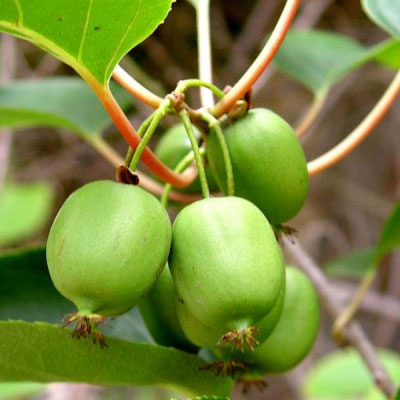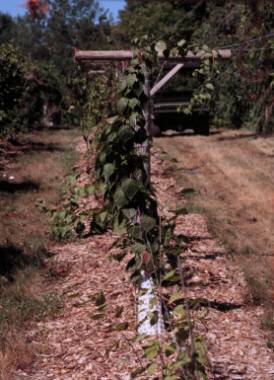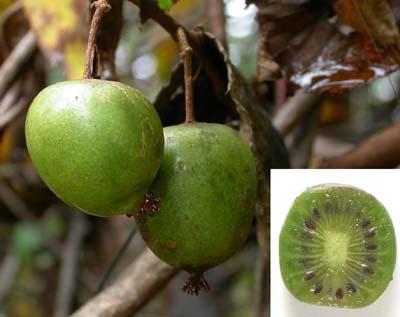
Hardy Kiwi: Actinidia arguta
 If
you don't live in the Deep South, you probably thought the luscious
kiwi fruit was beyond your grasp --- I know I did. Enter the
Hardy Kiwi (Actinia
arguta),
whose vigorous vines will ripen fruits up to zone 4. The Hardy
Kiwi originated in China, where it grows naturally in humid mountain
forests that share so many species with our own Appalachian
mountains. Asian people have eaten kiwis for centuries, and
in
1983, 130,000 tons of kiwi fruit were harvested from wild vines of
several kiwi species in China alone.
If
you don't live in the Deep South, you probably thought the luscious
kiwi fruit was beyond your grasp --- I know I did. Enter the
Hardy Kiwi (Actinia
arguta),
whose vigorous vines will ripen fruits up to zone 4. The Hardy
Kiwi originated in China, where it grows naturally in humid mountain
forests that share so many species with our own Appalachian
mountains. Asian people have eaten kiwis for centuries, and
in
1983, 130,000 tons of kiwi fruit were harvested from wild vines of
several kiwi species in China alone.
Hardy Kiwi produces
fruits that taste very similar to the kiwi fruits that you buy in the
store (from Actinidia
deliciosa),
but they are much smaller and are hairless. My understanding is
that you pop Hardy Kiwis in your mouth like grapes, and can also store
them in root-cellar-like conditions (just above freezing and at 95%
humidity) for nine months. Since one plant can produce up to 100
pounds of fruit, you might be able to provide your winter dessert with
just a few vines.
The internet is full of
sites singing the praises of the Hardy Kiwi, but it is sorely lacking
in specific cultivation information. Luckily, Uncommon
Fruits Worthy of Attention walks you through the whole
process from propagating to planting to pruning and harvesting.
Here's a quick summary:
Where
should I plant my Hardy Kiwi?
Hardy Kiwis are sensitive to late spring frosts, so they are best
planted on north-facing slopes where they are shaded from early spring
sun. Provide well-drained soil (or plant
on mounds), and build a strong trellis to support the plants.
Kiwis should be at least 15 to 20 feet apart.
Do I need more than one plant? Since Hardy Kiwis have
separate male and female plants, you will need to provide at least one
of each to produce fruit. Only one male is necessary for each
eight female plants, as long as the female plants are within 35 feet of
the male.

How do I train and prune my Hardy Kiwi?
The initial training is a lot like training a young grape vine.
During the first year, develop a trunk by training the strongest shoot
up along a one to two inch thick pole, cutting away all other
shoots.
When the trunk reaches the lowest trellis wire, split it into two
cordons by training one arm along the trellis in each direction.
Once cordons are seven feet long, cut them back to that length each
winter and develop fruiting arms at one foot intervals along the
cordon. At the same time that you cut back the cordons, prune
fruiting arms to
eight buds beyond where they fruited last year.
How do I propagate the Hardy Kiwi?
If you want to perpetuate the same variety, take cuttings. Hardwood
cuttings
work, but softwood cuttings root even more easily when taken from new
growth in early summer, removing the tips and clipping leaves in
half. Softwood cuttings will root in two to four weeks.
Hardy Kiwis can also be propagated from seed (although you will end up
with more variable offspring, half of which will be male.) To
grow them from seed, put the whole fruits in a blender with some water
just long enough to create a mush, then sow the pulp and seeds
together, stratifying for two months. Hardy Kiwis bear at two
years from cuttings and at three to four years from seed.

When do I harvest the fruits?
Hardy Kiwi fruits are ready to be picked when the seeds are black, even
though the fruits are still hard. Allow them to soften for a week
at room temperature.
Why is the Hardy Kiwi a permaculture
favorite?
Permaculture admonishes us to grow plants that are well-suited to our
environment and don't require lots of sprays and babying. The
Hardy Kiwi fits a niche very similar to a grape, but
seems to have no diseases or pests (beyond Japanese Beetles) in the U.S.
Are you growing them? We
planted two females (Dunbarton Oaks and Ananasnya) and a male in fall
of 2008. They sulked for the first year, but I hope they'll take
off this year --- I'll keep you posted.
| This post is part of our Uncommon Fruits Worthy of Attention
lunchtime series.
Read all of the entries: |
Want more in-depth information? Browse through our books.
Or explore more posts by date or by subject.
About us: Anna Hess and Mark Hamilton spent over a decade living self-sufficiently in the mountains of Virginia before moving north to start over from scratch in the foothills of Ohio. They've experimented with permaculture, no-till gardening, trailersteading, home-based microbusinesses and much more, writing about their adventures in both blogs and books.
Want to be notified when new comments are posted on this page? Click on the RSS button after you add a comment to subscribe to the comment feed, or simply check the box beside "email replies to me" while writing your comment.

Conservation farming in Zambia.
Rebecca --- good idea! I wonder if it's the calcium from the bones or the burst of organic matter they enjoyed?
Roland --- I finally got a chance to read that article you suggested. (Busy day today!) It was wonderful!!!!!!! So similar to all of the things I've been trying, like permanent beds, forest gardening, and no-till farming. I wish I could find a tree that dropped its leaves just as the planting season begins around here.
My attempt to propagate using a softwood cutting has met with some surprising results. For about two months, I've had a cutting sitting in water. Leaves were clipped as suggested in the article. The leaves are still as green as the day they were cut, but there are no roots!
I previously tried hardwood cuttings in a vermiculite mix using rooting hormone, but they just rotted.
Any thoughts or suggestions?
Has anyone had experience with rabbits and kiwi vines? Obviously, the vines will be fine once the stems get thick and they get up to regular height, but I'm planting new ones, which will be well within chewing range for a while.